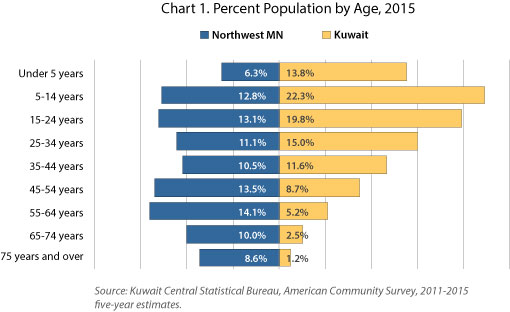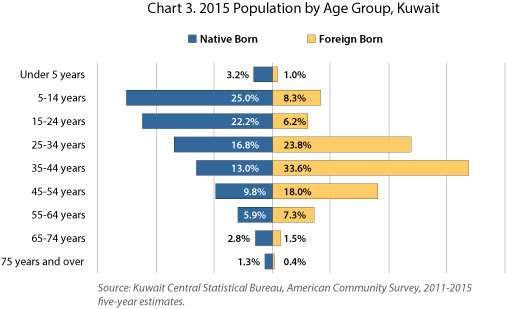by Chet Bodin
October 2019
In Northwest Minnesota regional industries and institutions are constantly working on ways to improve their workforce by making it easier for residents to participate and be part of the regional economy. To measure success the region is regularly compared to other parts of Minnesota or the United States. These comparisons clearly indicate that Northwest Minnesota is competitive in some areas and has opportunities to improve in others. These differences, however, can be highlighted further by comparing Northwest Minnesota to an area outside the United States with a vastly different culture and history. Kuwait is different from Minnesota in many ways, but like most countries, it strives to improve its economy and strengthen its workforce. This month's spotlight puts the local labor force side by side with one in a wholly different situation and finds that despite different dynamics, there are some similarities in the workforce challenges we both face.
One of the most noticeable features of the population and workforce in Northwest Minnesota is the age of its workforce. Across Minnesota and the United States, the generation of workers approaching retirement is starting to leave a significant void in the labor force, and their absence or anticipated absence is creating a challenge for employers who need to recruit and train their replacements. But in Northwest Minnesota nearly a quarter of the labor force is over the age of 55, and the drop in labor force participation of regional residents as they enter that age group is steeper than the average. Statewide, labor force participation dropped 43.5 percent between the age groups of 45 to 54 years of age and 55 years and older – a major change. But in Northwest Minnesota the change was 47.6 percent which indicates the challenge of replenishing the workforce there has been felt sooner and more acutely (see Table 1).
| Table 1. Employment Statistics by Age Group, 2015 | ||||||||
|---|---|---|---|---|---|---|---|---|
| Age Group | Northwest Minnesota | Minnesota | ||||||
| In Labor Force | Percent of Labor Force | Labor Force Participation Rate | Unemployment Rate | In Labor Force | Percent of Labor Force | Labor Force Participation Rate | Unemployment Rate | |
| 16 to 24 years | 45,654 | 15.9% | 69.5% | 10.0% | 447,406 | 14.9% | 69.0% | 11.5% |
| 25 to 34 years | 53,957 | 18.8% | 87.0% | 5.6% | 653,626 | 21.8% | 88.2% | 5.6% |
| 35 to 44 years | 51,562 | 18.0% | 88.2% | 4.2% | 589,581 | 19.7% | 87.9% | 4.3% |
| 45 to 54 years | 64,785 | 22.6% | 86.2% | 3.9% | 673,767 | 22.5% | 87.2% | 4.3% |
| 55 and older | 70,499 | 24.6% | 38.6% | 3.7% | 632,647 | 21.1% | 43.7% | 4.1% |
| Total Labor Force | 286,396 | 100.0% | 64.5% | 5.3% | 2,996,799 | 100.0% | 70.0% | 5.6% |
| Source: U.S. Census Bureau, American Community Survey, 2011-2015 five-year estimates | ||||||||
In comparison, only 6.9 percent of the labor force in Kuwait is comprised of workers over the age of 55. Although the older population in Kuwait participates in the labor force more often, their role is simply not the factor it is in the United States. Those between 45 and 54 years in Kuwait are also fewer to the extent that the percent of workers over 55 in the Northwest Minnesotan labor force is equal to the percent over 45 years in Kuwait (see Table 2).
| Table 2. Employment Statistics by Age Group, 2015 | ||||||||
|---|---|---|---|---|---|---|---|---|
| Rate | Northwest Minnesota | Kuwait | ||||||
| In Labor Force | Percent of Labor Force | Labor Force Participation Rate | Unemployment Rate | In Labor Force | Percent of Labor Force | Labor Force Participation Rate | Unemployment Rate | |
| 16 to 24 years | 45,654 | 15.9% | 69.5% | 10.0% | 103,104 | 4.7% | 25.2% | 15.3% |
| 25 to 34 years | 53,957 | 18.8% | 87.0% | 5.6% | 698,172 | 32.1% | 88.1% | 2.6% |
| 35 to 44 years | 51,562 | 18.0% | 88.2% | 4.2% | 815,430 | 37.4% | 89.3% | 1.3% |
| 45 to 54 years | 64,785 | 22.6% | 86.2% | 3.9% | 406,337 | 18.7% | 79.8% | 0.6% |
| 55 and older | 70,499 | 24.6% | 38.6% | 3.7% | 150,766 | 6.9% | 50.3% | 0.1% |
| Total Labor Force | 286,396 | 100.0% | 64.5% | 5.3% | 2,178,142 | 100.0% | 74.5% | 2.2% |
| Source: Kuwait Central Statistical Bureau, U.S. Census Bureau, American Community Survey, 2011-2015 five-year estimates | ||||||||
On the other end of the age spectrum, the participation of younger workers in Northwest Minnesota is a relative strength. In 2015 nearly 70 percent of residents 16 to 24 years of age were working or looking for work, which was slightly higher than the Minnesota state average and nearly three times higher than the same age group in Kuwait.
These workers made up almost 16 percent of the regional labor force in Northwest Minnesota, also higher than both areas of comparison (see Tables 1 and 2).
One of the major challenges for Kuwait, as such, is connecting their younger demographic to work. With a labor force participation rate of 25.2 percent, those 16 to 24 years of age make up less than 5 percent of the country's labor force. This statistic alone is sobering, but stands out even more when you consider the makeup of Kuwait's population.
In 2015 nearly 20 percent of Kuwaitis were 15 to 24 years old, not an insignificant portion. Only 13.1 percent of the population in Northwest Minnesota was 15 to 24 years of age, yet they contributed much more to the regional workforce and economy. Going further, in 2015 the percent of Kuwaitis 15 to 24 years old was second only to those 5 to 14 years of age, signaling that this issues may continue to present challenges in Kuwait in the years to come.

This is not to say that workforce development focused on initial entry in Northwest Minnesota is beyond reproach. Despite the high percent of labor force participation, the unemployment rate of those 16-24 years of age was 10 percent in 2015, the highest of any age group here.
While the demographics and the labor force trends in Northwest Minnesota and Kuwait are vastly different, both would benefit by improving the access to work for their youth and young adult populations. In Northwest Minnesota this would help to address the labor force shortage left by an exodus of older workers. Although the participation of youth and young adults in Kuwait is currently much lower, improving it could lead to vast growth in the country's labor force – the prospect of which is less promising in our part of the world.
In both Minnesota and Kuwait another factor in labor force development is their immigrant or foreign-born populations. Because a high percent of the 15 to 24 year age group already participates in the local labor force, immigrants may be critical to filling jobs left by older workers or to sustaining some level of labor force growth in the face of such a massive demographic shift. The opportunity is highlighted by the relative youth of foreign-born residents living in Northwest Minnesota. Over two-thirds of foreign born residents in Northwest Minnesota are between the ages of 15 and 44 compared to just one-third of native born residents (see Chart 2). As of 2017 the foreign-born population was only 2.1 percent of the total population in Northwest Minnesota or approximately 12,000 residents. But over a quarter of those foreign-born residents moved to the region since 2010, an increase over the previous two decades. A similar increase over the next decade could help address the workforce shortage, although it is projected that Northwest Minnesota will average over 30,000 vacancies a year from 2016-2026.

Conversely, the foreign born population in Kuwait is older than native-born Kuwaitis, of which over half are 24 years of age or younger. In this case over three fourths of immigrants are in their 'prime working years' or 25 to 54 years of age (see Chart 3). This reflects the fact that immigrants are a much larger part of Kuwait's workforce than in Northwest Minnesota. According to the Kuwait Central Statistical Bureau, nearly 80 percent of the Kuwaiti population are foreign-born, nearly all of whom moved to the small Arab country on temporary work visas. While the economy in Kuwait benefits greatly from foreign labor, it has also led to questions about whether more could be done to connect native-born Kuwaitis to the workforce, thereby easing the country's dependency on other sources.

It's clear that training youth for careers in the local economy is critical to the future workforce needs in both Northwest Minnesota and Kuwait. Their vastly different demographic dynamics lead, however, to different policy questions on the topic of foreign labor. In Kuwait it's clear that if they plan to build a stronger workforce from within, as some have suggested, it starts and ends with engaging Kuwaiti youth when they are 16 to 24 years of age and perhaps even sooner. In Northwest Minnesota there is also an opportunity to connect young jobseekers to work more often, particularly young immigrants, as regional labor demand continues to outweigh the native-born supply of workers. As the region moves forward in this area, perhaps there are lessons that can be learned from the experiences of other nations like Kuwait that have an extensive foreign-born labor force.